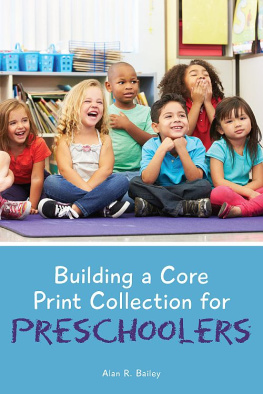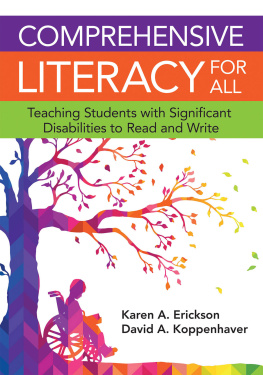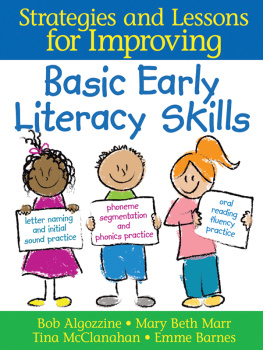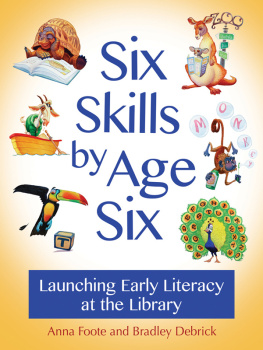
ALA Editions purchases fund advocacy, awareness, and accreditation programs for library professionals worldwide.
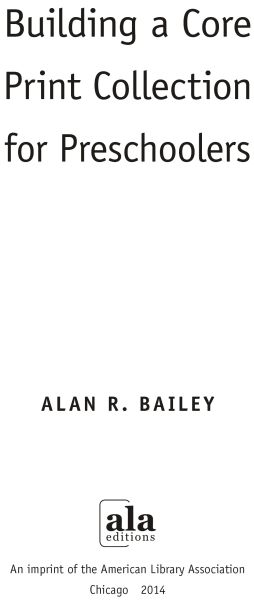
Over his thirty-year career as a professional librarian, Alan R. Bailey has served as a public school librarian and as a branch manager of a public library, and he has worked in community college and university libraries. For more than eighteen of those years, he has been directly responsible for developing collections for young children. A native of Washington, North Carolina, Bailey received his undergraduate degree from East Carolina University (Greenville, NC) and advanced degrees from East Carolina University and North Carolina Central University (Durham, NC). Alan currently serves as associate professor and education curriculum librarian in the Teaching Resources Center at East Carolina Universitys J. Y. Joyner Library. Bailey has served multiple terms as a member of the Coretta Scott King Book Awards Jury and has reviewed books for the Childrens Literature Review column in Language Arts: The Journal of the Elementary Section of the National Council of Teachers of English.
2014 by the American Library Association
Extensive effort has gone into ensuring the reliability of the information in this book; however, the publisher makes no warranty, express or implied, with respect to the material contained herein.
ISBNs: 978-0-8389-1219-5 (paper); 978-0-8389-1978-1 (PDF); 978-0-8389-1979-8 (ePub); 978-0-8389-1980-4 (Kindle). For more information on digital formats, visit the ALA Store at alastore.ala.org and select eEditions.
Library of Congress Cataloging-in-Publication Data
Bailey, Alan R.
Building a core print collection for preschoolers / Alan R. Bailey.
pages cm
Includes bibliographical references and .
ISBN 978-0-8389-1219-5 (print : alk. paper)ISBN 978-0-8389-1978-1 (pdf)ISBN 978-0-8389-1979-8 (epub)ISBN 978-0-8389-1980-4 (kindle) 1. Childrens librariesUnited StatesBook lists. 2. Preschool childrenBooks and readingUnited States. 3. Libraries and preschool childrenUnited States. I. Title.
Z718.2.U6B35 2014
027.62'5--dc23
2014001000
Cover design by Chelsea Cook. Image Monkey Business Images; Shutterstock, Inc.
Contents
What Is a Core Collection?
The titles selected and annotated in this book are examples of the most essential books for children from birth to age five. This noteworthy core collection, containing adeptly chosen books for preschoolers and representing a broad span of interests, backgrounds, abilities, and cultural experiences, enhances literacy skills, establishes and improves reading skills, and provides many learning advantages. These learning advantages include expressive and receptive language, expanded vocabularies, narrative skills, print awareness, the ability to understand written language, awareness of story structure, alphabetic knowledge, and phonological sensitivity.
Although this is a definitive list of core materials, it is not all-inclusive. Considering the multitude of materials published for children annually, readers are sure to find one or more of their personal favorites missing from this book. Readers will find, however, more than three hundred annotated citations that a broad range of children from birth to age five will find memorable and pleasurable while also having their intellectual, developmental, cultural, language, cognitive, creative, communication, and social needs met.
Why Is This Book Relevant?
Reading aloud clearly affects kindergarten readiness and lifelong literacy; therefore, reading to children is one of the most important things that educators, parents, and child-care professionals can do for a child. Years prior to entering school, a childs foundation for learning and experiencing formal reading instruction is in place, and reading to children daily enhances that foundation. Early exposure to books heavily influences vocabulary knowledge, which in turn improves reading skills and lifelong literacy. Primary skills books, nursery rhymes, wordless picture books, toy and movable books, rhyming books, fingerplays and action rhymes, and board books not only are entertaining and enjoyable to preschoolers but also are designed to meet their intellectual, developmental, cultural, language, cognitive, creative, communication, and social needs as well. Titles annotated in this book, in conjunction with the accompanying recommended resources, provide educators, child-care professionals, and parents with resources that are instrumental in providing preschool children the literacy foundations needed to succeed from kindergarten through their adult lives.
There is a critical need for a reference tool to assist librarians, professors, early childhood educators, parents, and other child-care providers of children from birth to kindergarten as they build recommended reading lists and core collections. Building a Core Print Collection for Preschoolers is that resource. In addition to being timely and essential, it is the only book devoted exclusively to creating a core collection for children in this age range.
Who Is the Audience for This Book?
The primary audience for Building a Core Print Collection for Preschoolers is practicing librarians. However, early childhood professionals, preservice teachers and librarians, parents, professors, and other child-care providers of preschool children will find this work equally significant. This unique book is a valued addition to every public library, elementary school library, and college and university library with early childhood education programs. It is a welcome addition to professional collections of both child-care centers and churches with vigorous youth programs, and it can serve as a required or recommended text for literature, reading, and early childhood classes on college and university campuses. In essence, Building a Core Print Collection for Preschoolers is the starting point for anyone establishing a preschool collection and an essential resource to individuals committed to expanding or enhancing an existing collection.
Which Criteria Were Used?
Reviews in professional journals; recommendations from librarians, parents, teachers, children, and other individuals involved in childrens literature; recommended reading lists; and many of the authors favorite childrens books provided the initial titles for the book. After I read each title, I considered a series of questions. I selected only those titles that received an overwhelming number of affirmative replies to the following questions:
Is the language clear and appropriate for children from birth to age five?
Are the illustrations clear and appropriate for children from birth to age five?
Does the complexity and development of the book match the childs developmental stage?
Is the text accurate?
Is the story clear?
Is the writing style consistent?
Does the book read aloud well?
Do the words and illustrations complement each other?
Do the illustrations primarily tell the story?
Does the story flow?
Will children be drawn to the book?
Does the book avoid gender, racial, and other stereotypes?
Overall, is the layout of the book, including font, colors, size, and so on, impressive?
Out-of-Print Titles
Unfortunately, several core titles listed in this book are no longer in print. For those titles, both new and gently used copies are available via Amazon.com and BookFinder.com. Both companies sell millions of used books, and you are likely to find the book you desire at a reasonable price.
Next page
